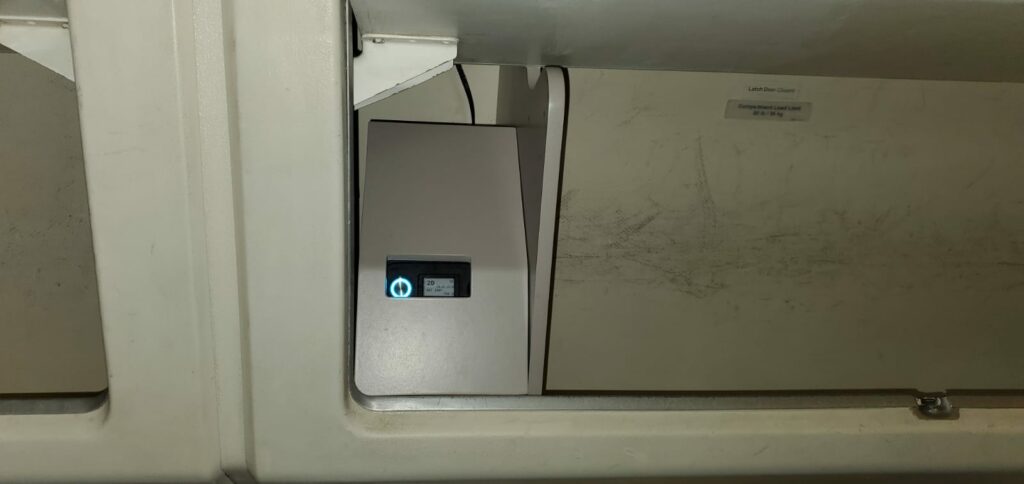Wireless inflight entertainment provider AirFi is rolling out updated charging logic for its semi-embedded boxes that use both battery and onboard power, following updated EASA safety guidance via a Certification Memorandum (CM).
That memorandum — CM-21.A-CS-001 Issue 02 on “Classification of design changes to cabin interiors of Large Aeroplanes” — highlights twenty specific areas in the cabin interior where the European Union Aviation Safety Agency wants to flag concerns. On charging, says EASA,
The introduction of facilities designed to stow PEDs during their battery recharge process may increase the risk of having a thermal runaway event that may involve multiple PEDs. The propagation of a PED fire to other PEDs may result in a fire event that may have catastrophic consequences. The installation of In-Seat Power Supply Systems (ISPSS) is not addressed by this item, provided that they are not installed in fully enclosed compartments.
This, of course, affects the wide and growing market for wireless inflight entertainment systems, many of which are the kind of battery-powered “box-in-bin” that recharge via the aircraft’s power system.
In essence, the regulator appears to be concerned that the combination of charging power supply, large batteries, air pressure changes, closed compartments and the absence of crew eyes on the devices while charging is too much of a safety risk.
The CM remains guidance, but it would be an unwise supplier or airline that failed to update their products to take it into account.
Job Heimerikx, chief executive officer at AirFi, tells Runway Girl Network that the company has already taken action to ensure that its autonomous semi-embedded boxes — those that are charged on board — charge only when at the gate or stand, or when taxiing to it.
Crucially, he says, the guidelines advise that airlines “do not charge any material in a closed compartment where you do not have any visibility on the product.”
As a result, AirFi has updated the logic on the company’s boxes so that “sensors in the box measure acceleration, temperature, air pressure — but most importantly, the ADS-B transceiver of the aircraft… it also determines when it is and when it is not allowed to charge the box.”
“Within the same approved framework as we do for the cellular network, and for the wifi — switching on and off — we also added the feature to switch on and off the charging of the batteries,” Heimerikx says.
The latest version of the box’s documentation seen by RGN states that, in the “Charging behaviour” section:
Charger logic has been upgraded based on recent EASA regulations changes. The AirFi Box will start charging the batteries as soon as the aircraft has “wheels on ground” in the following phases:
- TAXIING (after landing)
- PARKED
- TAXIING (before takeoff)
In any other case, charging will be disabled during the critical phases of the flight as well as CRUISING.
The standard configuration of the box when starting to charge when parked on the ground essentially searches for confirmation both from the box’s internal sensors and the ADS-B. In park, the ADS-B must be transmitting the ‘wheels on ground’ message and not be broadcasting its location and altitude position. Secondly, the box must be detecting no movement or unexpected air pressure.

AirFi’s semi-embedded boxes have updated logic to restrict charging to post-landing and parking flight phases. Image: AirFi
The triggers to stop charging are also multiple: ADS-B is transmitting ‘message 2’ with surface ground speed and locations, or the wheels-on-ground message; movement; or the air pressure changes associated with a closing door and pressurising cabin.
The triggers to start charging again during taxiing after landing are that the ADS-B is transmitting message 2 and wheels-on-ground.
For AirFi, this is an elegant solution leveraging its existing technology stack to adapt to the changing regulatory environment. But even more widely, the company’s willingness to discuss regulation changes, to be open about the challenges and how it is facing them, and to provide documentation to back it all up, is worthy of praise.
Related Articles:
- Portable Wi-Fi boxes gain in popularity at airlines, but are they safe?
- Astronics offers battery fire detection, cabin management bin sensors
- Kontron makes the leap into portable wifi and quickly gains traction
- Op-Ed: More discussion needed on how to best handle inflight PED fires
- Regulators flag fire risk of charging portable IFE in galley carts
- Onboard battery fires underscore need for meaningful action
Featured image credited to John Walton












